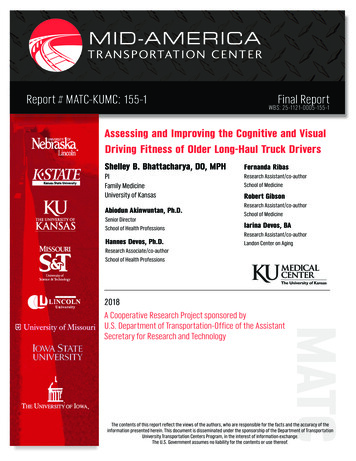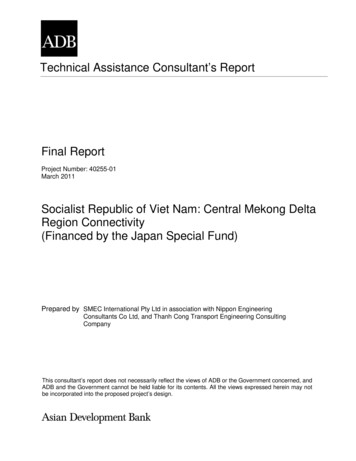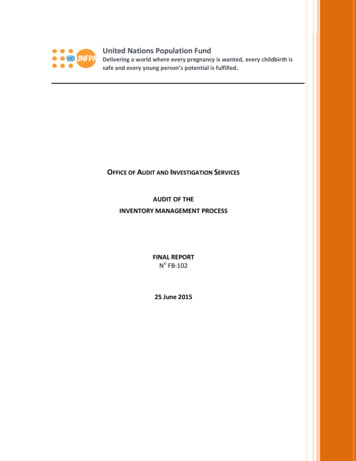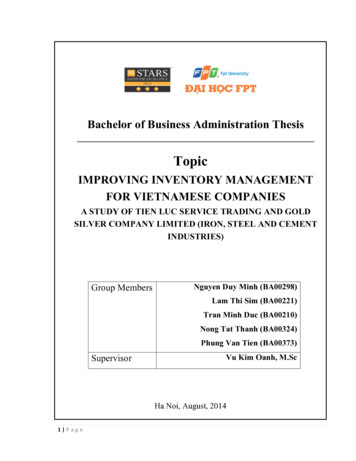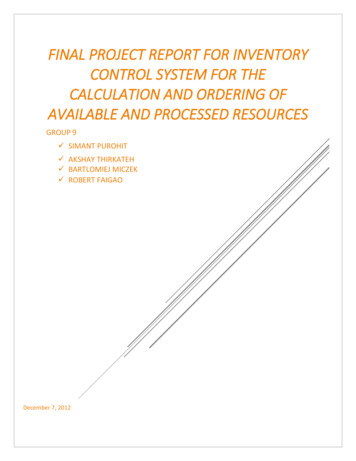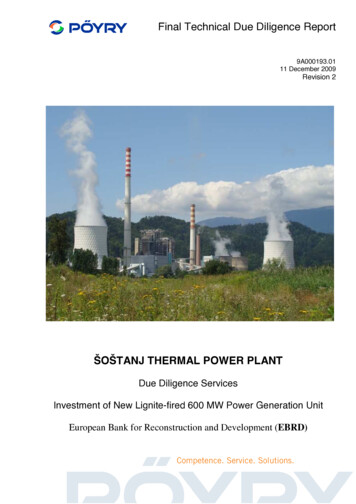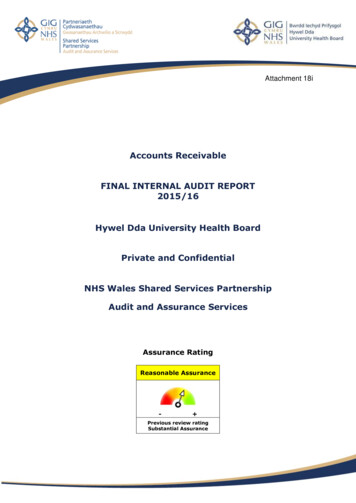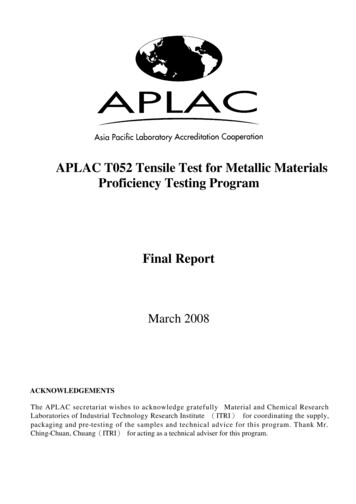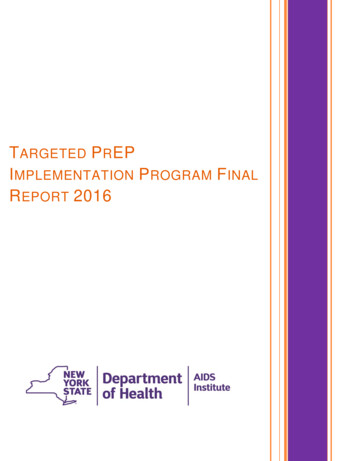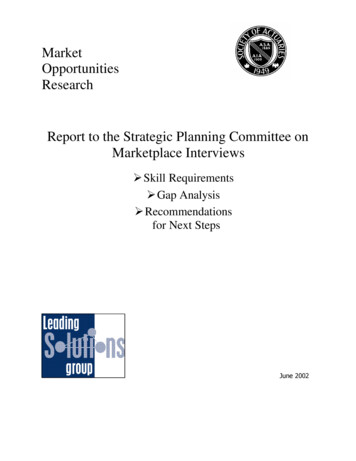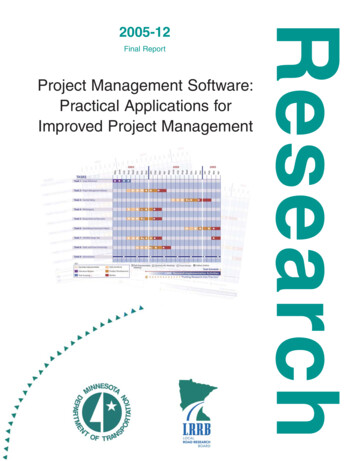
Transcription
Final ReportProject Management Software:Practical Applications forImproved Project ManagementResearch2005-12
Technical Report Documentation Page1. Report No.2.3. Recipients Accession No.MN/RC – 2005-124. Title and Subtitle5. Report DatePROJECT MANAGEMENT SOFTWARE: PRACTICALAPPLICATIONS FOR IMPROVED PROJECT MANAGEMENTJanuary 20057. Author(s)8. Performing Organization Report No.6.Michael M. Marti, P.E.Kathryn L. O’Brien, AICP9. Performing Organization Name and Address10. Project/Task/Work Unit No.SRF Consulting Group, Inc.One Carlson Parkway North, Suite 150Minneapolis, Minnesota 5544711. Contract (C) or Grant (G) No.12. Sponsoring Organization Name and Address13. Type of Report and Period CoveredMinnesota Department of TransportationResearch Services Section395 John Ireland Boulevard Mail Stop 330St. Paul, Minnesota 55155Final Report 2004(c) 83994 Task 214. Sponsoring Agency Code15. Supplementary Noteshttp://www.lrrb.org/PDF/200512.pdf16. Abstract (Limit: 200 words)Project management software is designed to make the job of a project manager easier and more efficient,providing applications to aid in planning, to manage project costs, and to track activities and monitor schedules.As more and more public works departments face the realities of increasing workloads and shrinking resources,finding technology applications that allow productivity gains becomes ever more important. The use of projectmanagement software as a tool for managing and organizing work has grown and continues to grow at a rapidpace in all industries. This paper reviews the ways in which it is currently being used in the course oftransportation project delivery in Minnesota, and provides a tool to assist in choosing the right application tomeet a local city or county’s needs.17. Document Analysis/Descriptors18.Availability StatementProject ManagementProject Management avera19. Security Class (this report)20. Security Class (this page)UnclassifiedUnclassifiedNo restrictions. Document availablefrom: National Technical InformationServices, Springfield, Virginia 2216121. No. of Pages3222. Price
Project Management Software:Practical Applications for Improved Project ManagementFINAL REPORTPrepared by:Michael M. Marti, P.E.Kathryn L. O’Brien, AICPSRF Consulting Group, Inc.One Carlson Parkway North, Suite 150Minneapolis, Minnesota 55447January 2005Published by:Minnesota Local Road Research BoardOffice of Research Services395 John Ireland Boulevard, Mail Stop 330St. Paul, Minnesota 55155This report represents the results of research conducted by the authors and does not necessarily represent the view orpolicy of the Minnesota Department of Transportation and/or the Center for Transportation Studies. This reportdoes not contain a standard or specified technique.The authors and the Minnesota Department of Transportation and/or Center for Transportation Studies do notendorse products or manufacturers. Trade or manufacturers’ names appear herein solely because they are consideredessential to this report.
ACKNOWLEDGEMENTSWe wish to thank the Minnesota Local Road Research Board (LRRB) and its ResearchImplementation Committee (RIC) for the financial support to make this important resource areality. The Technical Advisory Panel that steered this project was extremely helpful inidentifying key issues and concerns related to project management and the resources needed atthe local level. They also were very generous with their time to review the project managementapplications and provide oversight for this final document evaluating various products availablefor use by local city and county engineers.We appreciate the assistance of the following people who served on the Technical AdvisoryPanel for this resource document:John Rodeberg, City of Hutchinson, ChairJim Aamot, Mn/DOTTom Anton, Dakota CountyTim Eiler, University of MinnesotaAnn Johnson, PE Services, Inc.Dean Koutsoukos, Yaggy Colby & AssociatesSteve Kubista, Chippewa CountyRobert McPartlin, Mn/DOTMark Melby, Crow Wing CountyLyndon Robjent, Anoka CountySchane Rudlang, City of BloomingtonJim Weingartz, Mn/DOT
TABLE OF CONTENTSIntroduction.1Task Background and Purpose.1Project Management Software Survey Process .2City and County Engineer’s Survey .2Construction Financial Management Association Survey.3Software Evaluation Process.4Selection of Software Applications .4Development of Review Tools .5Evaluation Process .6Evaluation Results .7Appendix A: Editorial Comments from ReviewersAppendix B: Project Management Software Costs and RequirementsAppendix C: Project Management Software Review MaterialsAppendix D: Project Management Software Survey SummariesLIST OF TABLESTable 1Evaluation Results .8
INTRODUCTIONProject management software is designed to make the job of a project manager easier and moreefficient, providing applications to aid in planning, to manage project costs, and to trackactivities and monitor schedules. As more and more public works departments face the realitiesof increasing workloads and shrinking resources, finding technology applications that allowproductivity gains becomes ever more important. The use of project management software as atool for managing and organizing work has grown and continues to grow at a rapid pace in allindustries. This paper reviews the ways in which it is currently being used in the course oftransportation project delivery in Minnesota, and provides a tool to assist in choosing the rightapplication to meet a local city or county’s needs.TASK BACKGROUND AND PURPOSEThe Local Road Research Board (LRRB) undertook this research implementation study todevelop an understanding of how project management software was (or was not) currently beingused by county and city engineers in Minnesota, and to provide a tool summarizing anappropriate range of existing, commercially-available, project management tools. It is importantto note that the scope of this investigation was intended to encompass all phases of transportationproject development, from initial planning activities through final construction. Many productsare available to manage the process of construction; a tool that has broader applications foroverall project management, in addition to construction management, was the focus of thisinvestigation.This task was first proposed to the LRRB as a means of defining how technology applicationscould help city and county engineers better manage their projects. The observation was madethat, although technology was being used in many aspects of public works projects, there waslittle use of broad project management technology applications to attempt to manage multipleongoing projects, to archive project materials so they could be readily accessed when needed,and to comprehensively track project activities. Although there was some general understandingthat a few cities and counties may be using project management software, there was the beliefthat a more strategic summarization and evaluation of what off-the-shelf tools did exist tomanage public works projects was needed at this time.The resulting documentation should be understood as a review of project management softwaretools; not a recommendation for any one product. As discovered during the course of this task,project management software applications are designed to meet certain niche needs and thereforemust be evaluated on the course of their own merits. The decision to purchase and use oneproduct over another must be made based on the individual users’ or agencies’ requirements.Project Management Software:Practical Applications for Improved Project ManagementPage 1January 2005
PROJECT MANAGEMENT SOFTWARE SURVEY PROCESSIn order to determine current usage and desired functionality of project management software inMinnesota, two data sources were relied upon. The first tool was a survey developed andadministered by the Technical Advisory Panel (TAP) overseeing this research implementationtask, and the second tool was a survey conducted by the University of Minnesota’s ConstructionManagement Program.CITY AND COUNTY ENGINEER’S SURVEYOne of the first activities of this research implementation task was to survey Minnesota city andcounty engineers, querying them regarding their use of project management software, in additionto the desired functions of such software. An important distinction to make for respondents wasto discuss project management software, encompassing all phases of project development, notjust construction management software. The survey focused on determining whether respondentscurrently used any project management software, and whether this software was commerciallyavailable. In addition, a question was asked regarding the respondents’ opinion as to the mostimportant functions software should have to aid their project management.The survey was administered via e-mail, with a total of 43 responses submitted by the responsedeadline. Results of the survey are listed below each question. The percentage is calculated onthe total number of respondents that answered a particular question (i.e., if 43 people answeredquestion number one, the percentage of “yes” answers was calculated by dividing the number of“yes” votes by 43). Significant findings are summarized below, with the full survey summaryincluded in the appendix to this report. Few city or county engineers currently use project management software.Yes 5 responses (12 percent)No 38 responses (88 percent)43 people responded to this question Of those respondents using project management’s software, most use commercially availableproducts.Yes 4 responsesNo 1 response5 people responded to this question. Types of commercially available software used were listed as the following: Microsoft Project (three responses) FastTrack Schedule Plus v7.03 (AEC Software, Inc.)Project Management Software:Practical Applications for Improved Project ManagementPage 2January 2005
Important project management software functions were identified by the survey respondentsas follows. Ease of useCritical path tabilityScheduling(21 responses)(20 responses)(10 responses)(9 response)(5 responses)CONSTRUCTION FINANCIAL MANAGEMENT ASSOCIATION SURVEYThe Construction Financial Management Association, with support from the University ofMinnesota’s Construction Management Program, conducted a survey of software products usedby general contractors as part of construction management. Although focused on a more limitedspectrum of project development, namely the construction phase, this survey was examined aspart of the LRRB’s investigation of potential software for improved project management as someof the tools used may be applicable, with modifications, for other phases of projectdevelopment/management.The survey was administered to general contractors, highway and heavy (H&H) contractors, andspecialty contractors. A full summary is included in the appendix to this report, with noteworthyfindings summarized below. Almost a third of respondents (32 percent) indicated they did not use any projectmanagement software. Of those that were using software, two different Primavera packages, Primavera Expedition (18 percent) and Primavera Enterprise (6 percent) were the most commonlyused. The second most used software was Prolog Manager (Meridian Project Systems)used by 9 percent of respondents. (A total of 61 different project management softwarepackages were used by respondents.)General Contractors: General contractors were more likely than the overall group to useproject management software, with 25 percent using Primavera Expedition and17 percent using Prolog Manager.H&H Contractors: Overall, H&H contractors were not likely to use project managementsoftware (33 percent). Of those that do, Primavera Expedition is the most commonlyused package (38 percent).Specialty Contractors: Almost half of specialty contractors responding to the survey do notuse any project management software (47 percent). Of those that do, Primavera Expedition and Primavera Enterprise are the most commonly used.Project Management Software:Practical Applications for Improved Project ManagementPage 3January 2005
SOFTWARE EVALUATION PROCESSSELECTION OF SOFTWARE APPLICATIONSAfter completing the survey process, the next step in this research implementation task was todevelop a process to summarize an appropriate range of existing, off-the-shelf, projectmanagement applications. The outcome would be a tool to assist local jurisdictions in choosingthe appropriate application to suit their needs. Parameters established to guide this processincluded 1) that the application be appropriate for project management, not just constructionmanagement and, 2) that the application be an “off-the-shelf” product widely available.The survey of Minnesota city and county engineers was used as a starting point in theidentification of software applications. However, since only two off-the-shelf products wereident
efficient, providing applications to aid in planning, to manage project costs, and to track activities and monitor schedules. As more and more public works departments face the realities of increasing workloads and shrinking resources, finding technology applications that allow productivity gains becomes ever more important. The use of project management software as a tool for managing and .
